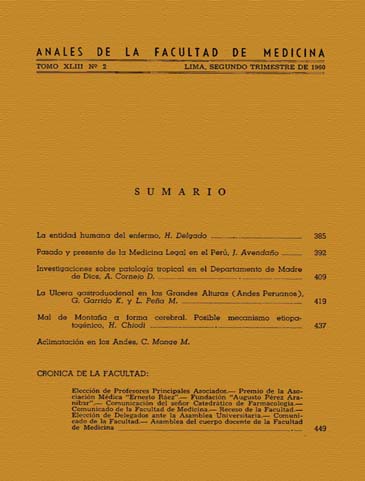Tropical Pathology Research in the department of Madre de Dios
DOI:
https://doi.org/10.15381/anales.v43i2.6300Abstract
Studying tropical deseases in the Department of Madre de Dios, we had the opportunity to colect some snakes there and in the city of Quincemil wich is situaded in the jungle of the Department of Cuzco, bordering with Madre de Dios. The snakes where studied by Dr. Jehan Vellard from the Museo de Historia Natural Javier Prado de la Universidad Nacional Mayor de San Marcos, who made the determinations. In this small collection there are specimens of the family Crotalidae,Elapidae and Colubridae. Among them there are specimens of solenoglipha, proteroglipha, opistoglipha and aglipha. We found the following species in the South.Orient: Bothrops castelnaudi (D. & B.), Lachesis muta (L.), Micrurus peruvianus, Micrurus hemprichii Jan, Xenodon severus (L.), Imantodes cenchoa (L.), Philodryas olfersii Lichtenstein, Oxybelis acuminatus Wied, Dipsa caterbyi Sentzen sp. and a specimen of the sub-family Rhadinea. Bothrops castelnaudi (D. & B.), has been found for the first time in Peru and with Lachesis Muta (L.), are the most dangerous snakes in that zone, it can be that they are responsible for almost every snake bite. It is confirmed that Madre de Dios is in the area of dispersion of Lachesis muta (L.), in Peru. Coral snakes are very common in this part of the jungle and the Micrurus peruvianus and Micrurus hemprihii Jan, has not been foud in Madre de Dios previously. Several specimens of Colubridae wich are not dangerous for men, were found in the South-Orient. Those are very common in the neighbor republic of Brazil.Downloads
Published
1960-06-13
Issue
Section
Trabajos originales
License
Copyright (c) 1960 Alberto Cornejo Donayre

This work is licensed under a Creative Commons Attribution-NonCommercial-ShareAlike 4.0 International License.
Those authors who have publications with this magazine accept the following terms:
- Authors will retain their copyrights and guarantee the journal the right of first publication of their work, which will be simultaneously subject to Creative Commons Attribution License that allows third parties to share the work as long as its author and its first publication this magazine are indicated.
- Authors may adopt other non-exclusive licensing agreements for the distribution of the version of the published work (eg, deposit it in an institutional electronic file or publish it in a monographic volume) provided that the initial publication in this magazine is indicated.
- Authors are allowed and recommended to disseminate their work over the Internet (eg: in institutional telematic archives or on their website) before and during the submission process, which It can produce interesting exchanges and increase quotes from the published work. (See El efecto del acceso abierto ).
How to Cite
1.
Cornejo Donayre A. Tropical Pathology Research in the department of Madre de Dios. An Fac med [Internet]. 1960 Jun. 13 [cited 2024 Aug. 16];43(2):409-18. Available from: https://revistasinvestigacion.unmsm.edu.pe/index.php/anales/article/view/6300















